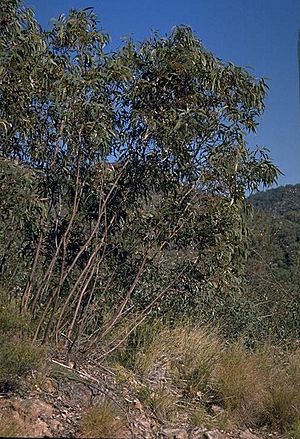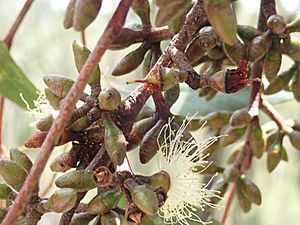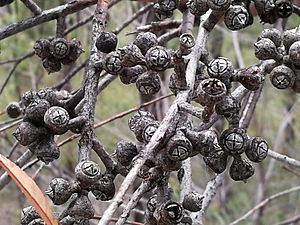Pokolbin mallee facts for kids
Quick facts for kids Pokolbin mallee |
|
|---|---|
 |
|
| Eucalyptus pumila at Pokolbin | |
| Conservation status | |
| Scientific classification | |
| Genus: |
Eucalyptus
|
| Species: |
pumila
|
The Pokolbin mallee (scientific name: Eucalyptus pumila) is a special type of eucalyptus tree. It is found only in New South Wales, Australia. This tree has smooth bark, long leaves, white flowers, and fruit shaped like a cup. It is named after the Pokolbin area where it grows.
Contents
What the Pokolbin Mallee Looks Like
The Pokolbin mallee is a type of mallee, which means it's a small, shrubby tree with multiple stems growing from the ground. It usually grows to be about 5 to 6 meters (16 to 20 feet) tall. This tree has smooth bark that looks copper-colored at first, then turns grey as it gets older. The bark peels off in strips.
Young Pokolbin mallee plants have egg-shaped leaves. These leaves can be up to 100 mm (4 inches) long and 60 mm (2.4 inches) wide. They have a small stalk, called a petiole, connecting them to the stem.
Adult Leaves and Flowers
The adult leaves are green on both sides. They are shaped like a spear or are slightly curved, measuring 50 to 160 mm (2 to 6 inches) long and 10 to 30 mm (0.4 to 1.2 inches) wide. These leaves also have a petiole, which is 8 to 20 mm (0.3 to 0.8 inches) long.
The flower buds grow in groups of seven. They are found where the leaves meet the stem. Each group of buds sits on a thick stalk called a peduncle, which is 6 to 15 mm (0.2 to 0.6 inches) long. Each individual bud has a smaller stalk, called a pedicel, about 2 to 5 mm (0.08 to 0.2 inches) long.
Mature buds are oblong or oval, about 7 to 11 mm (0.3 to 0.4 inches) long and 4 to 6 mm (0.16 to 0.24 inches) wide. They have a cone-shaped cap called an operculum. The Pokolbin mallee flowers are white and usually bloom between February and August.
Fruit of the Mallee
After flowering, the tree produces fruit. The fruit is a woody capsule that is shaped like a hemisphere or a cup. It is about 4 to 6 mm (0.16 to 0.24 inches) long and 7 to 9 mm (0.28 to 0.35 inches) wide. The parts that release the seeds, called valves, stick out strongly from the fruit.
How the Pokolbin Mallee Got Its Name
The Pokolbin mallee was first officially described in 1919 by a botanist named Richard Cambage. He wrote about it in a scientific journal.
The scientific name, pumila, comes from a Latin word, pumilis, which means "dwarf" or "small." This name refers to how this mallee is usually a smaller, shrubby tree compared to other tall eucalyptus trees.
Where the Pokolbin Mallee Lives
The Pokolbin mallee is only found in a small area. It grows at the northern end of the Broken Back Range, close to Pokolbin. It likes to grow in groups among sandstone rocks on steep hills. There are also old records of it being found near Wyong and Sandy Hollow.
Why This Mallee is Special
The Pokolbin mallee is considered a "vulnerable" species. This means it's at risk of becoming endangered if we don't protect it. Both the Australian Government and the New South Wales Government have laws to help protect it.
The main reasons it's vulnerable are:
- There are only a few of these trees left.
- Fires that happen too often or at the wrong time can harm the plants.
Images for kids







